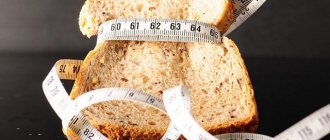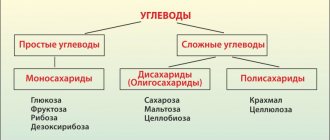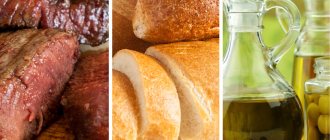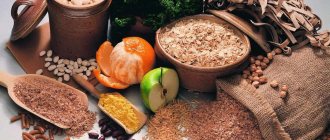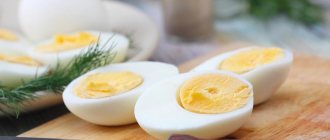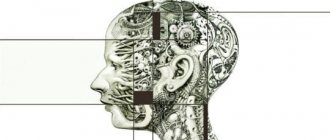Share:
We continue to consider the topic of metabolic processes. It's time to move on to fine-tuning the athlete's nutrition. Understanding all the nuances of metabolism is the key to athletic achievements. Fine-tuning will allow you to move away from classic dietary formulas and adjust nutrition individually to your own needs, achieving the fastest and most lasting results in training and competitions. So, let's study the most controversial aspect of modern dietetics - fat metabolism.
General information
Scientific fact: fats are absorbed and broken down in our body very selectively. So, in the human digestive tract there are simply no enzymes capable of digesting trans fats. The liver infiltrate simply seeks to remove them from the body in the shortest possible way. Perhaps everyone knows that if you eat a lot of fatty foods, it causes nausea.
Constant excess fat leads to consequences such as:
- diarrhea;
- indigestion;
- pancreatitis;
- rashes on the face;
- apathy, weakness and fatigue;
- the so-called “fat hangover”.
On the other hand, the balance of fatty acids in the body is extremely important for achieving athletic performance - in particular in terms of increasing endurance and strength. In the process of lipid metabolism, regulation of all body systems occurs, including hormonal and genetic ones.
Let's take a closer look at what fats are good for our body, and how to consume them so that they help achieve the desired result.
Types of fats
The main types of fatty acids entering our body:
- simple;
- complex;
- arbitrary.
According to another classification, fats are divided into monounsaturated and polyunsaturated (for example, here in detail about omega-3) fatty acids. These are healthy fats for humans. There are also saturated fatty acids, as well as trans fats: these are harmful compounds that interfere with the absorption of essential fatty acids, complicate the transport of amino acids, and stimulate catabolic processes. In other words, neither athletes nor ordinary people need such fats.
Simple
First, let's look at the most dangerous, but at the same time, the most common fats that enter our body - these are simple fatty acids.
What is their peculiarity: they decompose under the influence of any external acid, including gastric juice, into ethyl alcohol and unsaturated fatty acids.
In addition, it is these fats that become a source of cheap energy in the body. They are formed as a result of the conversion of carbohydrates in the liver. This process develops in two directions - either towards the synthesis of glycogen, or towards the growth of adipose tissue. Such tissue consists almost entirely of oxidized glucose, so that in a critical situation the body can quickly synthesize energy from it.
Simple fats are the most dangerous for an athlete:
- The simple structure of fats practically does not burden the gastrointestinal tract and hormonal system. As a result, a person easily receives an excess caloric load, which leads to excess weight gain.
- When they decay, alcohol, which is poisonous to the body, is released, which is difficult to metabolize and leads to a deterioration in overall health.
- They are transported without the help of additional transport proteins, which means they can stick to the walls of blood vessels, which can lead to the formation of cholesterol plaques.
For more information about foods that are metabolized into simple fats, see the Food Table section.
Complex
Complex fats of animal origin, with proper nutrition, are part of muscle tissue. Unlike their predecessors, these are multimolecular compounds.
Let us list the main features of complex fats in terms of their effect on the athlete’s body:
- Complex fats are practically not metabolized without the help of free transport proteins.
- When the fat balance in the body is maintained correctly, complex fats are metabolized to release healthy cholesterol.
- They are practically not deposited in the form of cholesterol plaques on the walls of blood vessels.
- With complex fats, it is impossible to get an excess of calories - if complex fats are metabolized in the body without insulin opening the transport depot, which causes a decrease in blood glucose.
- Complex fats burden liver cells, which can lead to intestinal imbalance and dysbiosis.
- The process of breaking down complex fats leads to an increase in acidity, which negatively affects the general condition of the gastrointestinal tract and is fraught with the development of gastritis and peptic ulcers.
At the same time, fatty acids with a multimolecular structure contain radicals bound by lipid bonds, which means they can denature to the state of free radicals under the influence of temperature. In moderation, complex fats are beneficial for an athlete, but they should not be subjected to heat treatment. In this case, they are metabolized into simple fats, releasing huge amounts of free radicals (potential carcinogens).
free
Free fats are fats with a hybrid structure. For an athlete, these are the most beneficial fats.
In most cases, the body is able to independently convert complex fats into arbitrary fats. However, during the lipid change process of the formula, alcohols and free radicals are released.
Consumption of arbitrary fats:
- reduces the likelihood of free radical formation;
- reduces the likelihood of cholesterol plaques;
- has a positive effect on the synthesis of beneficial hormones;
- practically does not burden the digestive system;
- does not lead to excess calories;
- do not cause an influx of additional acid.
Despite many beneficial properties, polyunsaturated acids (in fact, these are arbitrary fats) are easily metabolized into simple fats, and complex structures that have a lack of molecules are easily metabolized into free radicals, obtaining a complete structure from glucose molecules.
Obesity
Obesity is an excess amount of neutral fat in subcutaneous fat. There are two types of obesity – primary and secondary.
Primary obesity
It is a consequence of energy imbalance as a result of physical inactivity and overeating. In a healthy body, the amount of food absorbed is regulated by the adipocyte hormone leptin. Leptin is produced in response to an increase in fat mass in the cell and ultimately suppresses feeding behavior by reducing the formation of neuropeptide Y in the hypothalamus, which stimulates food seeking. In 80% of individuals with primary obesity, the hypothalamus becomes insensitive to leptin, and 20% have a defect in leptin structure.
Leptin also increases vascular tone and increases blood pressure.
A typical example of low pathogenic obesity is the obesity of sumo wrestlers. Despite the obvious excess weight, sumo masters maintain relatively good health for a long time due to the fact that they do not experience physical inactivity, and weight gain is associated exclusively with a special diet enriched with polyunsaturated fatty acids. But after stopping their sports career, in order to maintain their health, they have to return their weight to universal norms. And, nevertheless, the consequences of former excess body weight appear with age.
Secondary obesity
Occurs with hormonal diseases. Such diseases include, for example, hypothyroidism (), hypercortisolism ().
Treatment principle
When treating obesity, it is first necessary to take into account the fact that any obesity is a matter of balance, i.e. energy inflow and outflow.
- increasing physical activity - optimally 3 times a day for 20-30 minutes until a state of mild fatigue, while the load should be aerobic and as the body weight decreases, the intensity of the load should increase,
- a diet with a sharp reduction in the amount of sweet foods and saturated fats (dairy products, cheese, butter, lard, fatty meat) with moderate consumption of black bread, cereals, cereals, vegetable oils and fish, the introduction of ω3-series fatty acids into the diet, which facilitate lipolysis ,
- it is possible to take biologically active food supplements (BAA) that suppress lipogenesis, stimulate lipolysis and oxidation of fatty acids (citrimax, guarana, L-carnitine), multivitamin and polymineral preparations with mandatory physical activity,
- in case of secondary obesity, treatment of the underlying disease is mandatory.
At the Scottish Maryfield Clinic in 1965-1966, patient Angus Barbieri consumed only tea, coffee, soda water and vitamins for 382 days and lost weight from 214.1 kg to 87.4 kg.
What does an athlete need to know?
Now let’s move on to what an athlete needs to know about lipid metabolism in the body from the entire biochemistry course:
Point 1. Classic nutrition, not adapted for sports needs, contains many simple fatty acid molecules. This is bad. Conclusion: radically reduce your fatty acid intake and stop frying in oil.
Point 2. Under the influence of heat treatment, polyunsaturated acids break down into simple fats. Conclusion: replace fried foods with baked ones. The main source of fats should be vegetable oils - season salads with them.
Point 3 . Avoid eating fatty acids with carbohydrates. Under the influence of insulin, fats, practically without the influence of transport proteins, enter the lipid depot in their complete structure. In the future, even during fat burning processes, they will release ethyl alcohol, and this is an additional blow to metabolism.
And now about the benefits of fats:
- Fats must be consumed, as they lubricate joints and ligaments.
- In the process of fat metabolism, the synthesis of basic hormones occurs.
- To create a positive anabolic background, you need to maintain a balance of polyunsaturated omega 3, omega 6 and omega 9 fats in the body.
To achieve the right balance, you need to limit your total calorie intake from fat to 20% of your overall meal plan. It is important to take them in combination with protein foods, and not carbohydrates. In this case, transport amino acids, which will be synthesized in the acidic environment of gastric juice, will be able to almost immediately metabolize excess fat, removing it from the circulatory system and digesting it to the final product of the body's vital activity.
Regulation of lipid metabolism
Lipid metabolism is regulated by the nervous system (diencephalon) and endocrine glands. Of the endocrine glands (the activity of which is in turn regulated by the nervous system), fat metabolism is influenced by the pituitary gland, thyroid gland, gonads, adrenal gland and pancreas.
If the activity of these regulatory systems is disrupted, very severe, morbid obesity of the animal can occur.
Categories: Metabolic pathways Anabolism Catabolism Lipids
On this page there is material on the following topics:
regulation of lipid metabolism is
mineral-water metabolism physiology
lipid metabolism report
the importance and role of metabolism
Product table
| Product | Omega-3 | Omega-6 | Omega-3: Omega-6 |
| Spinach (cooked) | – | 0.1 | Residual moments, less than a milligram |
| Spinach | – | 0.1 | Residual moments, less than a milligram |
| Fresh trout | 1.058 | 0.114 | 1 : 0.11 |
| Oysters | 0.840 | 0.041 | 1 : 0.04 |
| Fresh tuna | 0.144 — 1.554 | 0.010 – 0.058 | 1 : 0.005 – 1 : 0.40 |
| Pacific cod | 0.111 | 0.008 | 1 : 0.04 |
| Pacific mackerel fresh | 1.514 | 0.115 | 1 : 0.08 |
| Fresh Atlantic mackerel | 1.580 | 0.1111 | 1 : 0. 08 |
| Fresh Pacific herring | 1.418 | 0.1111 | 1 : 0.08 |
| Beet tops. poached | – | Residual moments, less than a milligram | Residual moments, less than a milligram |
| Atlantic sardines | 1.480 | 0.110 | 1 : 0.08 |
| Swordfish | 0.815 | 0.040 | 1 : 0.04 |
| Rapeseed liquid fat in the form of oil | 14.504 | 11.148 | 1 : 1.8 |
| Palm liquid fat in the form of oil | 11.100 | 0.100 | 1 : 45 |
| Fresh halibut | 0.5511 | 0.048 | 1 : 0.05 |
| Olive liquid fat in the form of oil | 11.854 | 0.851 | 1 : 14 |
| Atlantic eel fresh | 0.554 | 0.1115 | 1 : 0.40 |
| Atlantic scallop | 0.4115 | 0.004 | 1 : 0.01 |
| Sea shellfish | 0.4115 | 0.041 | 1 : 0.08 |
| Liquid fat in the form of macadamia oil | 1.400 | 0 | No Omega-3 |
| Liquid fat in the form of flaxseed oil | 11.801 | 54.400 | 1 : 0.1 |
| Liquid fat in the form of hazelnut oil | 10.101 | 0 | No Omega-3 |
| Liquid fat in the form of avocado oil | 11.541 | 0.1158 | 1 : 14 |
| Canned salmon | 1.414 | 0.151 | 1 : 0.11 |
| Atlantic salmon. farm raised | 1.505 | 0.1181 | 1 : 0.411 |
| Atlantic salmon | 1.585 | 0.181 | 1 : 0.05 |
| Turnip leaf elements. stewed | – | Residual moments, less than a milligram | Residual moments, less than a milligram |
| Dandelion leaf elements. stewed | – | 0.1 | Residual moments, less than a milligram |
| Stewed chard leaves | – | 0.0 | Residual moments, less than a milligram |
| Fresh red lettuce leaf elements | – | Residual moments, less than a milligram | Residual moments, less than a milligram |
| Fresh leafy elements of yellow lettuce | – | Residual moments, less than a milligram | Residual moments, less than a milligram |
| Fresh leafy elements of yellow lettuce | – | Residual moments, less than a milligram | Residual moments, less than a milligram |
| Collard kale. stewed | – | 0.1 | 0.1 |
| Kuban sunflower liquid fat in the form of oil (oleic acid content 80% or higher) | 4.505 | 0.1111 | 1 : 111 |
| Shrimps | 0.501 | 0.018 | 1 : 0.05 |
| Coconut liquid fat in the form of oil | 1.800 | 0 | No Omega-3 |
| Cale. stewed | – | 0.1 | 0.1 |
| Flounder | 0.554 | 0.008 | 1 : 0.1 |
| Cocoa liquid fat in the form of butter | 1.800 | 0.100 | 1 : 18 |
| Caviar black and red | 5.8811 | 0.081 | 1 : 0.01 |
| Mustard leaf elements. stewed | – | Residual moments, less than a milligram | Residual moments, less than a milligram |
| Fresh Boston salad | – | Residual moments, less than a milligram | Residual moments, less than a milligram |
